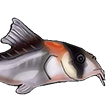Miguel Mancini, M., Marzuoli, J.O., Silva, P., Varela, G., Salinas, V., Silva, M., & M. Garro. (2024). Primer registro del bagre amarillo Pimelodus maculatus (Siluriformes, Pimelodidae) en la provincia de Córdoba (Argentina). Historia Natural, 14(2): 43-52.
PDF: https://fundacionazara.org.ar/img/revis ... _43-52.pdf
Key words. Ichthyofauna, Córdoba, Siluriformes, yellow catfish, Pimelodus.Abstract.
Studies of ichthyofauna in Argentina have gained greater relevance in recent years and are constantly being updated. The yellow catfish () has a wide distribution in the country and neighboring countries, but it was not part of the fish fauna of the province of Córdoba. The objective is to report for the first time its presence in the provincial territory. Fish were captured in the Tercero river (32º41’09’’S 62º29’14’’W) and in La Helvecia shallow lake (33º25’35’’S 62º53’25’’W), located in Del Saladillo wetlands. Meristic and morphometric characters and somatic relationships of nine specimens are presented. In addition, water characteristics of the lentic environment are provided. From this work is broaden the western distribution of P. maculatus in central region of Argentina.











